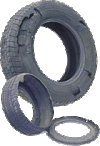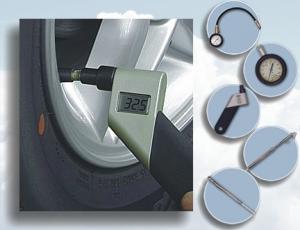Inflating your tires
The tire and rim assembly is an air chamber that, when inflated to the proper pressure, supports the weight of the vehicle. Since the air pressure supports 95% of the weight, inflation is a critical part of a tire's ability to perform.
You can't tell if your tires have enough air just by looking at them. Even though they may look fine, they may be underinflated by as much as 20%. According to a recent study, about 70% of the vehicles on the road in Canada have at least one tire that is either over or underinflated by more than 10%. In fact, 23% of all vehicles surveyed had at least one tire underinflated by 20%. This represents a real safety issue.
Underinflation increases rolling resistance, which reduces tread life and increases fuel consumption. It can also lead to sudden tire failure. Without enough air, the sides of a tire bend and flex too much. This builds up heat, which can cause serious damage. Operating a vehicle with just one tire underinflated by 56 kPa (8 psi) can reduce the life of the tire by 15,000 km and can increase the vehicle's fuel consumption by 4%.
|
Underinflation is the number one enemy of a tire. Operating an underinflated or overloaded tire at highway speeds on a warm summer day is a recipe for tire failure.
|
|
|
- Use a good-quality gauge to measure the pressure of each tire. The pocket gauges sold by automotive supply stores are generally more accurate than those on gas station air pumps.
- Measure the pressure when your tires are cold, and don't forget the spare. Tires will be cold if the vehicle has been stationary for at least three hours or has not been driven more than 2 km.
- Remember that tires lose pressure when the air temperature gets colder (about 7 kPa or 1 psi for every 5°C drop in temperature). Tires may also lose a certain amount of pressure due to their permeability (about 14 kPa or 2 psi per month).
- Overinflation can be a problem too. An overinflated tire rides on just the centre portion of the tread. The smaller contact area means reduced grip on the road, leading to a harsh ride, handling issues (such as steering and stopping problems) and increased wear on tires and suspension components.
Be sure to add air to your tires during the winter months. Make certain that both the air pump hose valve and the tire valve are free of snow and other debris that could cause a leak in the tire valve. Don't forget to put the cap back on the tire valve when you're done.
|
|
|
|
|
Tire pressure gauges sold by automotive supply stores are generally more accurate than those on gas station air pumps. |



